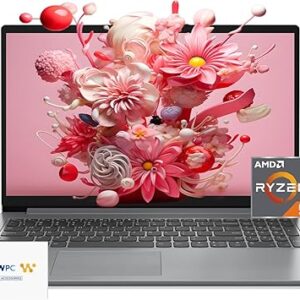You can always enjoy the age-old battle between the chips and cores of a laptop. Although both AMD and Intel are trustworthy, and considered powerhouses for decades. Choosing between them can be a daunting task as both offer distinct qualities, driving innovation and fueling the performances of our computers.
It doesn’t matter if you’re a budget-conscious gamer, a video-editing pro, or someone who just wants a reliable workhorse, understanding the key differences between the AMD laptop Vs. Intel laptop is crucial.
AMD laptop Vs. Intel laptop: Choose your powerhouse
The CPU, or central processing unit, is the main component responsible for most of the calculations and instructions executed by a computer, and selecting the best option for your needs will have a substantial impact on how the computer performs. In the realm of processors, two major players dominate: Computer designers are AMD and Intel. Both provide meaningful potential however understanding the kind of potential each chip possesses user can enable the user to choose the most suitable chip.
Price and Value:
AMD: Sometimes offers improved value through better cost-effectiveness. Ryzen offers more cores and threads per dollar and is perfect for budget PC users and gamers who need multitasking.
Intel: Some of the high-end models come equipped with higher clock speeds, but they may be more expensive.
Performance:
AMD: Built on top of a core and thread count; displays enhanced effectiveness in multi-threading applications, such as video editing and 3D rendering.
Intel: Historically used as single-core processing machines, which are best suited for demanding processes such as high framerates, and single-threaded use cases. The latest ones provide amazing clock speed and IPC (instructions per clock) improvements.
Integrated Graphics:
AMD: In general, integrated graphics also known as Radeon Graphics are said to be a bit weaker compared to Intel.
Intel: Non-designated graphics (Intel UHD Graphics) are usually faster and therefore more suitable for budget layouts without graphics cards.
Upgradeability:
AMD: Main features include backward compatibility with earlier Ryzen generations, so updating to a newer AM4 socket could save money on a CPU upgrade.
Intel: The most significant socket type change happens more often, and entails an upgrade in the motherboard to boot along with the CPU.
The Factors that Decide who is the best
It will come down to what you would prefer and what is most important to you. Here’s a quick breakdown:
- Gamers: If framerate is your top priority and you want to get the most out of your processor in terms of gaming performance, Intel may be your best bet. Yet, for the budget-savvy gamers, who are not willing to compromise the multi-tasking capabilities of their CPU, AMD Ryzen is worth looking at.
- Content Creators: But if you have to edit videos or for that matter, any intensive application that needs a plethora of cores and threads, AMD shines through. Still, the top-of-the-line Intel chips are capable of standing their ground in simple operations like code compilation which single cores are capable of.
- Budget Builds: AMD processors are more commonly associated with more cores and features for less money, so it is an excellent decision for people who want to save money.
Which one is better: AMD or Intel?
Selecting the best one for your laptop might be a big deal but at the same time, it is similarly difficult to choose one. Each one is best in its own league. So which one should you get? Well here is a better analysis of what you might need.
The Price-conscious Powerhouse: AMD
Affordability: In terms of price, AMD chips are more affordable than those of Intel in most cases and perform great for mainstream usage such as web browsing, typing documents, and media streaming.
Multitasking Maestro: AMD excels at tasks that heavily utilize the number of cores and threads, which include video editing and multitasking. Complex scheduling is not an issue since you can work on and manage different programs without experiencing any productivity loss.
Battery Life Considerations: Though certain AMD laptops offer better battery backup, still, Intel processor still offers a slightly better result in this context, especially for lesser usage.
The Single-Core Speed King: Intel
Intel is the other company that could be considered a great example of the strategies described above, with its main focus being on developing processing technologies that are consistently faster and more efficient than those of its competitors.
Gaming Prowess: When it comes to intensive gaming on the move, the single-core performance of Intel processors is unrivaled, meaning better frame rates in the most graphically demanding titles.
Thin and Light Compatibility: For instance, various models of notebooks based on Intel processors are often seen in ultraportable devices because they are designed to consume less power than certain AMD counterparts.
Integrated Graphics Advantage: The integrated graphics processors such as Intel UHD Graphics are seen as more suitable than AMD’s Radeon Graphics which make Intel GPUs suitable for gaming and other basic operations that involve graphics without requiring the use of a dedicated graphics card.
A Tale of Two Titans: AMD laptop Vs. Intel laptop
AMD and Intel are both long-standing competitors within the realm of personal computers, defining technology aspects and pushing high performance for quite some time now. Here’s a glimpse into their intertwined history:
Humble Beginnings (1960s-1970s):
Both were established in the 1960s with Intel being formed early in 1968 whereas AMD was formed the following year.
To begin with, they were involved in the production of different products – Intel was targeting the production of memory chips only and AMD was producing a variety of electronic items.
The x86 Dance (1980s):
In 1982, IBM, which was initially using Intel chips in its IBM PC, which it intended to develop into the new standard, licensed AMD. This enabled mounting copies of Intel’s 8086 and 8088 microprocessors, thus starting the first rivalry between the two companies.
During the 80s, AMD also came up with compatible processors that are often considered cheaper versions compared to Intel alternatives.
The Innovation Spark (1990s):
In the early 1990s, AMD entered into a new strategic development when it began to work on its microprocessor designs rather than using licensed technology. This period witnessed the introduction of the AMD Am386 and Am486, which began to even compete with Intel.
The actions laid out above proved to be crucial and the increased competition was put in evidence by the release of the AMD K6 in 1997. It offered direct competition to Intel’s Pentium chips and solved the problem of a better-performing chip at a low price. This intense competition was very aggressive and helped in pushing both companies to innovate.
The Core Wars (2000s-present):
Introduced in the early 2000s, AMD introduced its Athlon processor line that incorporated features of on-die L2 cache and support for Double Data Rate RAM to improve performance.
Intel responded to the competition with the launch of its Pentium 4 and Core series processors. Both companies focused on frequencies, cores, and efficiency, producing computers containing some of the fastest chips of that time.
In 2003, AMD was the first one to bring 64-bit processors into the market through its Athlon 64 soon securing the crown for a short period.
It remains today as both companies never cease to improve and innovate the processor located in a computer. The battle is between the AMD Ryzen series and the Intel Core i series at the moment; both products are top-notch for owning desktops and laptops.
Making the Perfect Match: How to Decide?
Consider your priorities to determine the ideal processor for your laptop:
Everyday User: When it comes to what you will be using your computer for in 2021, such as web browsing, document editing, and streaming, an affordable yet efficient AMD processor can suffice.
The Multitasking Master: When it comes to heavy operations such as video editing or 3D rendering, the fact that there are more cores and threads in AMD equipment could make a big difference in terms of efficiency.
The Gamer on the Go: For enthusiasts who require optimal performance in high-end games demanding the best frame rates in eSports games or other modern games, the Intel processor could be the best option considering the optimization of single-core performance.
Ultraportable Needs: If portability is of greatest value and thin and light designs are given preference, then Intel chips are more often used in such notebooks because of their lesser power requirements.
Ryzen v/s Intel: If you’re still unsure whom to choose
We get it, it must be difficult to choose a processor over the other when there are so many factors to oversee. However, we are here to help you to max and make a decision. So here’s what we have for you. Specs of both the processors because you must know what you need, Strength because you must know what you want, Advantages because you must know if you need what you want, and Disadvantages to check out everything you need.
Specs:
- Intel: It is also characterized by higher base and boost clock speeds that can translate into improved performance in tasks that require bursts of speed.
- Ryzen: Usually has more cores and threads and this is reflected in better results in different applications especially those engaging multiple threads.
Strengths:
- Intel: Outperforms rivals in single-threaded operations, which is useful for high frame rate gaming and such chores as compiling code.
- Ryzen: Outperforms in tasks that require multiple threads such as video editing and 3D model rendering owing to the core and thread.
Advantages:
- Intel: More characteristic of thin and light devices mainly because of low energy usage in some models. UHD integrated graphics (Intel) are said to be better for basic multimedia functions when not coupled with a discrete GPU.
- Ryzen: Pricewise, more often than not they are less expensive than their corresponding laser counterparts and are perfect for everyday and multiple uses. AMD’s AM4 socket is used in desktops, and it supports backward compatibility across several Ryzen generations of processors, meaning you may not need to spend money on new sockets for the next upgrade.
Disadvantages:
- Intel: Is potentially more costly for such a solution to be delivered with similar peak performance compared to Ryzen. Socket configurations shift much more often for desktops, so one is likely going to need a new motherboard when swapping CPU types.
- Ryzen: Integrated graphics (Radeon Graphics) are not quite as strong as Intel’s offerings. AMD-powered notebooks may have slightly shorter battery life compared to their Intel counterparts.
The Verdict:
So, you might have noticed that Intel can be more favorable for those gamers who focus on the aspects of raw performance. However, for content creators and multitasking people who heavily depend upon the number of cores and threads, Ryzen is a gem. As for cost savings, AMD processors are preferred by several clients with a limited budget. In conclusion, it can be stated that if you pay enough attention to the choice, you will need to choose the best option for you. Hence you should consider the workload to be undertaken, the necessary budget required, and the features that are to be incorporated in the system.





